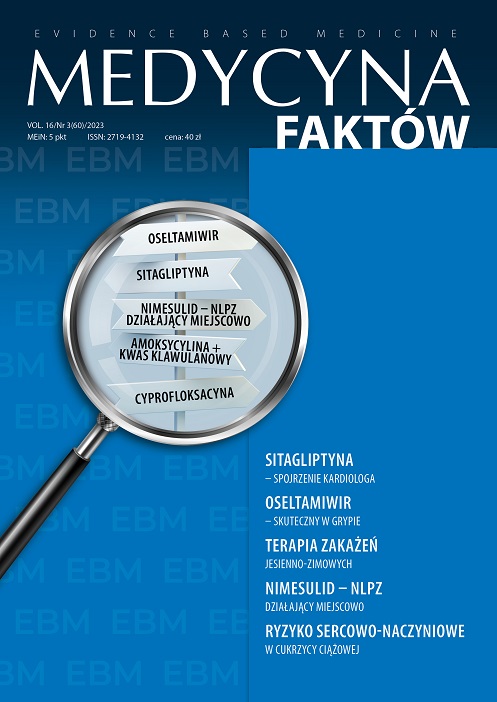Latest data regarding properties and clinical use of rosuvastatin Review article
Main Article Content
Abstract
Statins are a fundamental part of treatment in primary and secondary prevention of atherosclerotic cardiovascular disease. Rosuvastatin, which has been acknowledged in the international guidelines for many years as a substance which effectively modifies lipid metabolism parameters, presents one of the available therapeutic options for patients requiring intensive statin therapy (e.g., after an acute coronary syndrome or with concomitant diabetes and high cardiovascular risk). In this article, we take a look at recently published papers, which outline the features that potentially distinguish rosuvastatin in relation to other therapeutics in this drug group. These include a greater reduction in LDL-C in the blood as well as better safety profile when compared to atorvastatin. Moreover, rosuvastatin appears to have stronger anti-inflammatory properties.
Article Details
Copyright © by Medical Education. All rights reserved.
References
2. Howard JP, Wood FA, Finegold JA et al. Side Effect Patterns in a Crossover Trial of Statin, Placebo, and No Treatment. J Am Coll Cardiol. 2021; 78(12): 1210-22.
3. Ibanez B, James S, Agewall S et al. 2017 ESC Guidelines for the management of acute myocardial infarction in patients presenting with ST-segment elevation: The Task Force for the management of acute myocardial infarction in patients presenting with ST-segment elevation of the European Society of Cardiology (ESC). Eur Heart J. 2018; 39(2): 119-77.
4. Collet JP, Thiele H, Barbato E et al. 2020 ESC Guidelines for the management of acute coronary syndromes in patients presenting without persistent ST-segment elevation. Eur Heart J. 2021; 42(14): 1289-367.
5. Grundy SM, Stone NJ, Bailey AL et al. 2018 AHA/ACC/AACVPR/AAPA/ABC/ACPM/ADA/AGS/APhA/ASPC/NLA/PCNA Guideline on the Management of Blood Cholesterol: Executive Summary: A Report of the American College of Cardiology/American Heart Association Task Force on Clinical Practice Guidelines. Circulation. 2019; 139(25): e1046-e81.
6. Mach F, Baigent C, Catapano AL et al. 2019 ESC/EAS Guidelines for the management of dyslipidaemias: lipid modification to reduce cardiovascular risk. Eur Heart J. 2020; 41(1): 111-88.
7. Rahhal A, Khir F, Orabi B et al. A Comparative Study of High-intensity Rosuvastatin Versus Atorvastatin Therapy Post-acute Coronary Syndrome Using Real-world Data. Curr Probl Cardiol. 2022; 47(7): 100956.
8. Jones PH, Davidson MH, Stein EA et al. Comparison of the efficacy and safety of rosuvastatin versus atorvastatin, simvastatin, and pravastatin across doses (STELLAR* Trial). Am J Cardiol. 2003; 92(2): 152-60.
9. Leiter LA, Rosenson RS, Stein E et al. Efficacy and safety of rosuvastatin 40 mg versus atorvastatin 80 mg in high-risk patients with hypercholesterolemia: results of the POLARIS study. Atherosclerosis. 2007; 194(2): e154-64.
10. Karlson BW, Palmer MK, Nicholls SJ et al. To what extent do high-intensity statins reduce low-density lipoprotein cholesterol in each of the four statin benefit groups identified by the 2013 American College of Cardiology/American Heart Association guidelines? A VOYAGER meta-analysis. Atherosclerosis. 2015; 241(2): 450-4.
11. Stein B, Ward T, Hale G et al. Safety of High-Intensity Statins in the Veteran Population: Atorvastatin 40 to 80 mg Compared With Rosuvastatin 20 to 40 mg. Ann Pharmacother. 2020; 54(5): 405-13.
12. Werida R, Khairat I, Khedr NF. Effect of atorvastatin versus rosuvastatin on inflammatory biomarkers and LV function in type 2 diabetic patients with dyslipidemia. Biomed Pharmacother. 2021; 135: 111179.
13. Hartleb M, Wunsch E, Cichoż-Lach H et al. Postępowanie z chorymi na niealkoholową stłuszczeniową chorobę wątroby (NAFLD) – rekomendacje dla lekarzy podstawowej opieki zdrowotnej. Opracowane na podstawie zaleceń Polskiej Grupy Ekspertów NAFLD. Lekarz POZ. 2019; 5(5): 323-34.
14. Woźniak E, Broncel M, Niedzielski M et al. The effect of lipid-lowering therapies on the pro-inflammatory and anti-inflammatory properties of vascular endothelial cells. PLoS One. 2023; 18(2): e0280741.
15. Henein MY, Vancheri S, Longo G et al. The Role of Inflammation in Cardiovascular Disease. Int J Mol Sci. 2022; 23(21): 12906.
16. Libby P, Ridker PM, Maseri A. Inflammation and atherosclerosis. Circulation. 2002; 105(9): 1135-43.
17. Crouse JR, 3rd, Raichlen JS, Riley WA et al. Effect of rosuvastatin on progression of carotid intima-media thickness in low-risk individuals with subclinical atherosclerosis: the METEOR Trial. JAMA. 2007; 297(12): 1344-53.
18. Zheng H, Li H, Wang Y et al. Rosuvastatin Slows Progression of Carotid Intima-Media Thickness: The METEOR-China Randomized Controlled Study. Stroke. 2022; 53(10): 3004-13.

